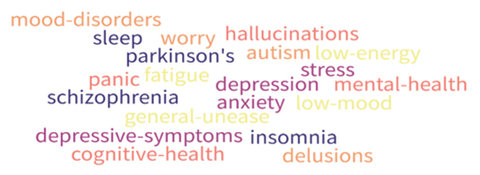DRIVING MARKET OPPORTUNITIES
IN THE GUT-BRAIN AXIS SECTOR
PROBIOTICS

The GBA Concept highlights that the nervous system and the gastrointestinal tract are communicating through a bidirectional network of signalling pathways called the gut-brain axis (GBA), which consists of multiple connections (1). The gut microbiota has emerged as one of the key components of gut-brain function. Research focused on the distinct microbiota-GBA has gained traction in multiple diverse fields, such as, neurodevelopmental, cognition, sleep science and neurodegenerative disorder management. Gut microbes interact with the GBA via various routes including, for example, the vagus nerve and the enteric nervous system involving production of microbial metabolites, such as, short chain fatty acids, branched chain amino acids, and peptidoglycans, immune system effects, tryptophan metabolism, altered intestinal permeability, gut hormone signalling. From a commercial perspective, venturing into unchartered territory always requires a sharp focus. GBA product innovation from asset identity to commercialization is daunting, as the research area has multiple diverse targets of commercial interest spanning consumer and pharmaceutical platforms. These include, for example, sleep, cognitive support at the consumer end to potential therapeutic products, for depression, schizophrenia and Alzheimer’s management. Thus, a robust end to end assessment is required at the outset to ensure delivery of commercially viable products.

INTRODUCTION
There is a great unmet need that research on the GBA may address as the global burden of disease attributable to mental disorders has risen inexorably in all countries (2). Mental health problems exist along a continuum from mild, time-limited distress to chronic, progressive, and severely disabling conditions. From diffuse, non-specific symptoms causing intermittent mental distress to clear syndromes causing increasingly severe functional impairment. However, despite research advances showing what can be done to promote mental health and to prevent and treat mental disorders, translation into real-world effects has been slow. Global mental health burden data show that the share of population with mental health disorders in 2019 reached up to 20% share in some geographies (2).
UNMET NEED
What is required to unlock the translation of the emerging science developments in the GBA microbiome space? A detailed gap analysis was carried out by an ILSI Europe Joint Nutrition Cluster focusing on mechanistic insights into GBA (3). This activity resulted in an open access publication which included rich insights into what is required to advance the field. Progress has been made in characterizing the bidirectional interactions between the gastrointestinal tract, central nervous system and the enteric nervous system. However, results to date are largely based on studies in (germ-free) animals. It is acknowledged also that the gut microbiota play a key role in relation to the GBA and that probiotic- and antibiotic-driven gut microbiota modulations can exert modulatory effects on some of these parameters, at least, in animals. While there has been an increase in clinical research over the last 5 years, (based on a pub-med search), less than 2% of publications relate to human clinical trials. In addition, trials conducted are often characterized by low numbers of subjects, short timeframes and often report conflicting results. Reassuringly, the number of randomized controlled GBA-related trials registered is increasing. This is particularly the case in Europe and USA and entails nutrition type trials focused on maintaining mood and therapeutic trials focused on mood disorders. However, further well-designed double-blind trials are warranted to underpin the area. As the ILSI group highlighted, a lot yet needs to be done; the development of robust models and validated tools for studying bidirectional communication pathways. Importantly also as GBA research is-cross disciplinary in nature, collaboration and partnerships are imperative to accelerate translation and market dynamics (3).
UNLOCKING POTENTIAL
Regulation of products targeting the GBA via the microbiome, for example, is complex with potentially multiple routes/product classifications possible; diverse health outcomes; multiple markets to consider with different regulatory requirements and often an absence of Standards and Guidance. A clear regulatory strategy is required at the outset to ensure successful translation of research, as requirements and business models differ significantly. A strategy which considers the product attributes, the claims, the optimal regulatory routes and requirements, the risks, existing standards and guidance, and possibility for acceleration helps inform decision making.
Importantly food pathways include those for foods for the general population and for specifically targeted special groups including patients under medical supervision. A comprehensive continuum of health claims exists for foods from maintaining health to risk factor reduction and dietary management of disease. Key aspects of bringing new food product innovations with health benefits to the market are ensuring the underpinning science is robust and the benefits are communicated. When it comes to communicating claims, for generic claims in EU, for example, as long as the product can comply with the mandated conditions of use, the claim can be used. However, human studies are required to support certain health claim authorizations. Care is required in the design of food-related human nutritional studies in EU to ensure they are not considered clinical trials which fall under the Clinical Trials Regulation (4) which came into application this year and prior authorization is a requirement. Similarly in USA, determining whether an IND is required or not is a critical determination that impacts research programmes and launch timelines.
REGULATORY HURDLES
To date, though the science is still emerging, there is evidence of considerable market activity related to GBA products. In a detailed report entitled ‘The gut brain axis: psychobiotic opportunity in 25 countries’, Starling and Hudson (5) provide details of some 215 brands and insights on the tremendous opportunities that exist in the sector. Data continue to accumulate from Horizon 2020 research to the EU flagship research and innovation framework Horizon Europe. The ERC MINERVA (Microbiota-Gut-BraiN EngineeRed platform to eVAluate intestinal microflora impact on brain functionality) project explored the relation between the intestinal microflora and the brain in the development of neurodegenerative disorders like Alzheimer's and Parkinson's disease. Industry is also actively funding e.g., ‘Global Grants for Gut Health’ was a competitive programme supported by Yakult and Nature Research. Research activity is intensifying also, recent findings from Vauzour and colleagues, link changes in the gut microbiota and the hippocampus in the context of high fat diet-induced obesity and anxiety in animals, and they also demonstrated that dietary intervention with a small cup of cranberries provided daily for 12 weeks improved episodic memory performance and neural functioning in humans (6,7).
With an estimated compound annual growth rate in the region of 20% in the next 5 years predicted, this is an area where research will continue to gain momentum. If the research ambitions are realized, the GBA area has tremendous commercial potential, far out-rivaling ‘immunity’ or ‘gut health as targets, as it impacts many aspects of human physiology (mood, cognitive decline in ageing, stress) and diseases, such as, irritable bowel syndrome, autism, anxiety, depression, Alzheimer’s and Parkinson’s disease. Thus, commercially it is likely to be both a vibrant consumer health and pharma play.
BRIGHT HORIZONS
Bio...

Colette Shortt (PhD, MBA) is an independent regulatory specialist and a registered nutritionist with 30 years industry experience, holding Global and European scientific and regulatory leadership roles in companies, such as, SB, Yakult and J&J. She has successfully coordinated one of the first disease risk reduction health claim dossiers in EU, is active in advisory boards focussed on innovation (NICHE, EC Microbiome Projects Masters and MicrobiomeSupport and is a Visiting Professor to the Ulster University.
COLETTE SHORTT
Regulatory & Nutrition Specialist | United Kindgom

PEER REVIEWED



